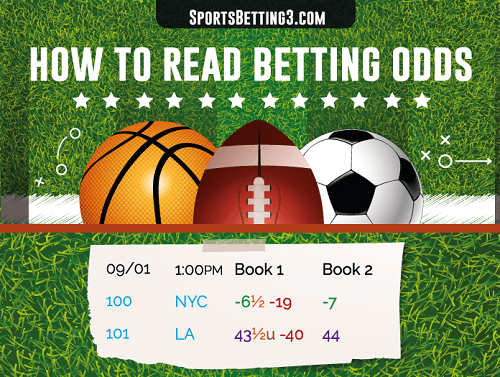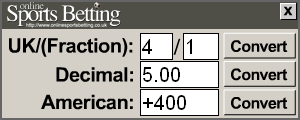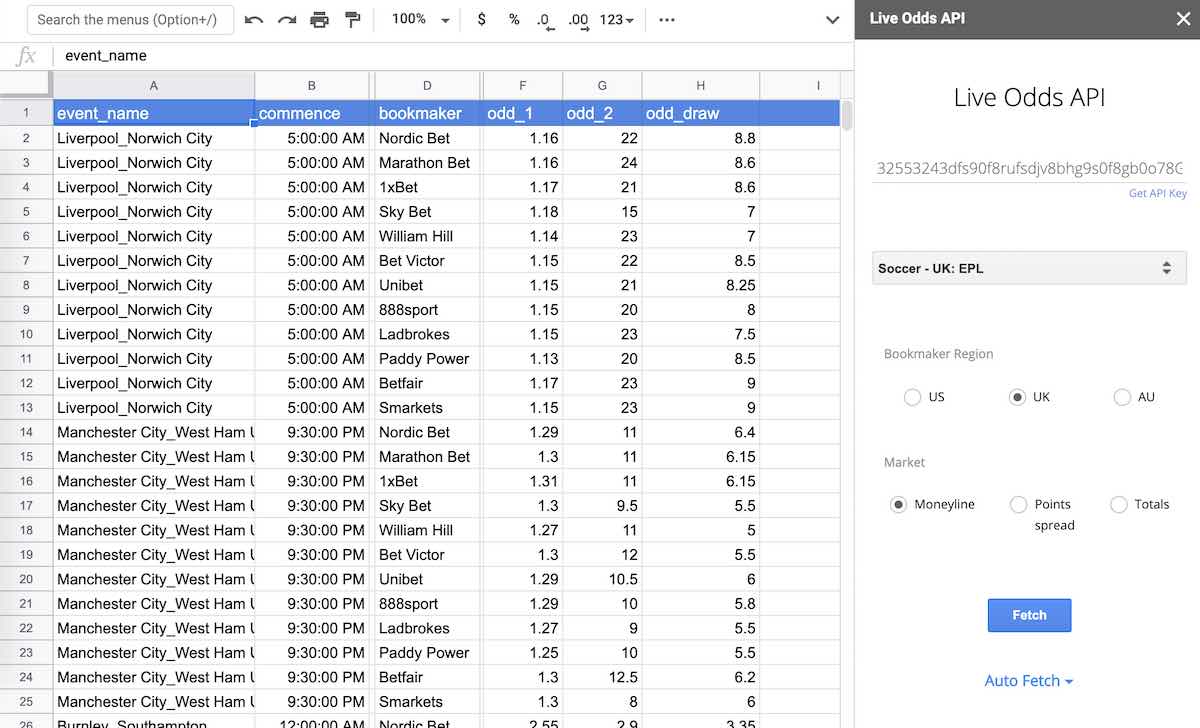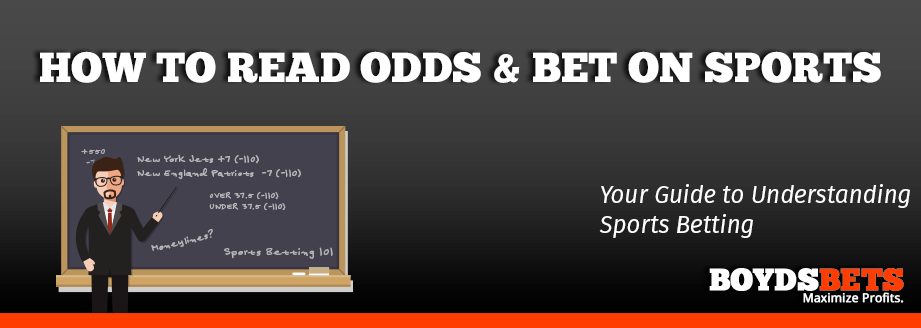How Are Odds Calculated In Sports

Sports betting odds are calculated with the main goal for sportsbooks being to receive equal money on both sides of a bet.
For example, if the Kansas City Chiefs are a -10 point favorite against the Oakland Raiders and are getting 90% of the money, the sportsbook would likely adjust their line so they don't finish in the negative if the Chiefs cover that spread. And so, the sportsbook will continue to raise the line until the other side starts receiving action (from 10.5 to 11 to 11.5, etc). While receiving equal money isn't always possible, it's always the goal because if that's the case, the sportsbook will come out in the positive no matter the final result.

- These odds suggest that if this fight happened 21 times (8 + 13), Golovkin would lose 8 bouts and win 13. To calculate the implied probability of Golovkin winning the fight, take the number of times he is expected to win (13) and divide it by the total number of trials (21). This results in a 61.9% chance Golovkin will win the fight.
- Parlay Calculator. A parlay is a single bet that links together two or more individual wagers for a high payout. A 2 team parlay might pay 13/5, a three team parlay might pay 6/1, a four team parlay might pay 10/1, and so forth with the payouts getting higher with more teams or totals selected. For a single bet, 2 to 8 teams or totals can be.
- The latest news, videos, scores and more on the biggest sports, including NFL, NBA, MLB, NCAA, NASCAR and more with Sporting News.

A betting odds calculator allows users to input their stake & odds format they desire (American, Decimal, or Fractional) and quickly calculates the potential return of bets made. A bet calculator is ideal for providing an accurate idea of the bettors’ potential winnings for all types of sports wagers, including standard single bets, using. The odds, how do they work? We are offering a comprehensive view of what sports bets are, and therefore a chance of improving and increasing your odds in understanding how to calculate sports odds. This is essential if you want to place bets and be successful. You have a wide range of sports events you can place your bets on.
That's because of the vig, or the amount the sportsbook charges for taking a bet. In the above situation, if equal money was put on the Chiefs -10 (-110) and Raiders +10 (-110), the sportsbook would finish in the positive no matter the result. Say there is one bet on each side, $110 to win $100. If the Chiefs win by seven points and don't cover, the Chiefs bettor is out $110, while the Raiders bettor is up $100. That extra $10 goes to the sportsbook because of the -110 odds and that's why the sportsbook wants equal money.
To understand how odds are calculated, it's best to learn what they specify. Sports betting odds and lines specify the implied probability of an outcome and how much money can be won.
Odds can refer to moneyline, spread or total bets, and they can be displayed as American, British (fractional) or European (decimal). While odds look different, they mean the same thing.
American Odds
Most sportsbooks in the United States use American Odds. The main signifiers of American odds are that they either have a plus (+) or minus (-) in front of them and are in terms of 100.
Understanding plus (+) and minus (-) odds is the most important thing before learning about American odds.
Plus and Minus Odds
The plus (+) and minus (-) in sports betting can refer to either the point spread or betting odds. In terms of the spread, the ' - ' always refers to the favorite and the ' + ' always refers to the underdog. For example, you can bet the Dallas Cowboys as a -7 point favorite to beat the Green Bay Packers or the Packers as a +7 point underdog. If you bet the Cowboys -7 and they win by more than seven points, you win your bet. Similarly, if you bet the Packers +7 and they lose by less than seven points or win outright, you win your bet.

It's a similar case for the betting odds, though favorites don't always have a ' - ,' especially in sports like baseball, hockey or soccer where final results are often decided by one run or one goal. It's especially the case in soccer since matches can end in draws, whereas a winner is declared in almost every other sport because of overtime rules. However, in most cases, the favorite will have a ' - ' in front of its moneyline odds while the underdog will always have a ' + .'
For an example of moneyline betting odds, you can bet the Eagles as a -150 favorite to win or the Giants as a +180 underdog to win. If you bet $100 on the Eagles to win at -150, you would net a payout of $166.70. If you bet on the Giants to win at +180, the payout would be $280 because they are an underdog.
For something like soccer, Arsenal could be a +150 favorite against Everton as a +190 underdog, while the draw would be set at +220. In this case, the payout would be decent for every situation mainly because the teams are even and there are three possible results compared to just two for something like football (unless they go scoreless in overtime). In this case where both teams have a ' + ' in front of their odds, the team with the lower number is the favorite. The lower number also means a lower payout, which is always the case for betting the favorite on the moneyline. A $100 bet on Arsenal +150 would net $250, while a $100 bet on Everton +190 would net $290. Going further, a $100 bet on the draw at +220 would payout $320.
Moneyline Bets
A moneyline bet is on the straight-up winner of a game.
Moneyline bets are as straightforward as it gets in sports betting. You're betting on which side will win an event and if that side wins, you win.
Spread Bets
A spread bet is on the forecasted point differential between two teams. A minus (-) indicates the favorite and a plus (+) is the underdog.
In each bet, a push is also possible if the Lakers win by exactly seven points. That would mean each side gets their money back.
What Are The Odds Calculator
As for the odds, the most common number for spread bets is -110, but that number varies depending on the location, sportsbook and how popular each side is. The typical number is -110, which means you have to bet $110 to win $100. However, there are states where odds are worse in order to get the state more money such as -115 or -120. This is also called the vig, which is the amount the sportsbook charges per bet.
If two teams are equal, PK will be given alongside a team name which means the matchup is considered a 'pick 'em.' In this case, point spread doesn't matter as this boils down to a moneyline bet and a tie would get your money back.
Over/under (total) Bets
Calculate Sports Betting Payout
An over/under bet applies to the score or points in a given contest.

The below over/under table is for the Dallas Cowboys and New York Giants game.
Similar to a spread bet, if the Cowboys and Giants combine for exactly 49 points, it's a push and each side get their money back. Also similar to spread bets is that the odds can vary.
Decimal Odds (British)
Decimal odds are most popular in Australia, Canada, Europe and New Zealand. These odds may be the easiest of the three to understand just by looking at the numbers.
Gambling Calculator
The team with the higher of the two numbers is the underdog and the team with the lower of the numbers is the favorite. The return can be calculated by multiplying the bet with the the decimal odds.
Fractional Odds (European)
Fractional odds are most popular in the United Kingdom and Ireland, and are often the choice for horse racing. Also, a lot of sportsbooks in the United States will use fractional odds for futures odds.
Example odds to win the Super Bowl:
Similar to decimal odds, the return can be determined by multiplying the odds and the bet. Above, 100 times 2.5 (5/2) equals 250. In horse racing, odds will dip to something like 3/5 or 5/7 which usually means that horse is a big favorite. A 3/5 favorite is equal to -167 in American odds and 1.6 in decimal odds.